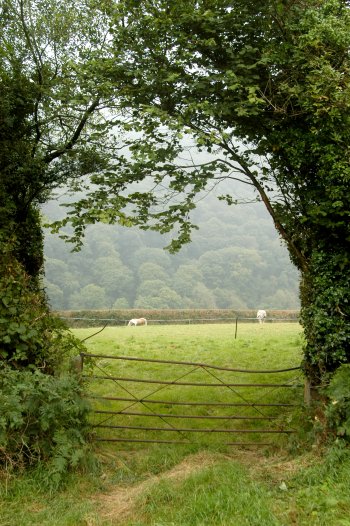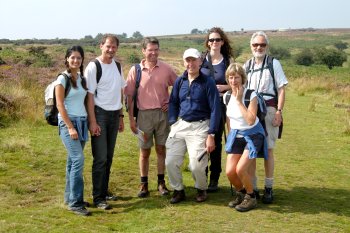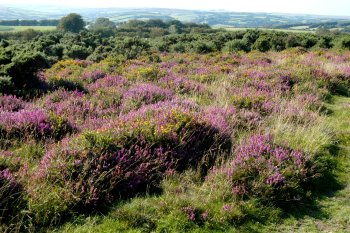

|
|
|
|
|
|
|
|
|
|
|
Exford, Exmoor National Park, Somerset 2nd - 4th September 2005 |
|
|
|
Much to my surprise, Xerox Hiking Club secretary, Jenny van der Meijden, had asked me to make the necessary arrangements via e-mail to summon the troops for this hiking trip in Exford, Exmoor National Park, Somerset. I accepted the challenge with relish, though, to be fair, much of the preparation gets done by John Adams, who sees to most of the shopping and Peter Mathews, whom one simply cannot imagine not being involved. It took a while but eventually we had a sizeable group. I was quite chuffed with this trip because I had originally proposed it after having passed through Exmoor National Park on some previous occasion. |
|
|
 |
I had managed to arrange a lift with Gordon Farquhar, travelling down the M4 and part of the M5. We took the exit at junction 27 and onto the A361 / A396. Things started to go awry, however, when Gordon's automated car navigation system started playing silly buggers with us. Owing to slight inaccuracies on the narrow roads, it kept instructing us to take turn-offs into the back of beyond. We soon realised we were being led up the proverbial garden path, a bit like a dog chasing its tail, as we doubled back in virtual tiny circular routes off the 'A' road. It was in this manner that we unintentionally found ourselves on the B3227. |  |
|
Shortly after leaving Exford Youth Hostel, we found ourselves in the fields, in thick mist; Beautiful farmhouse buildings, don't know where - Martin reckons Nethercote. |
|
|
| After several more corrections, we managed to get back onto the A396, cutting through the beautiful village of Dulverton, where I made a mental promise to myself that I would return someday with my bicycle. It was on the final approach to Exford on the B3223 that we courted near disaster, saved only by the instinctive driving of Gordon. It was getting dark rapidly around 20h00 and we almost didn't see black cattle crossing the road, silhouetted against the sun on the horizon. Some slick, neat manoeuvring from the driver and imminent danger was narrowly averted. Talk about living on the edge! We arrived at the hostel with not a soul in sight. |  |
 |
|
Up a hillside lush in ferns; Looking back down the same path. |
|
|
 |
|
The 16th Century White Horse pub across the road adjacent to the common, proved a good watering hole upon arrival, after a long drive. Susanna, Lisa's friend arrived sans Lisa, who is still suffering terribly after months of back problems and did not make it on the trip. John, Tim and Bernard had arrived the day before and already done a walk on the Friday. John Adams, with all the time in the world at his disposal, is usually the first to arrive on most trips. He had travelled with Bernard as his passenger and it was with them that I made an early arrangement to grab a lift back to Welwyn. |
|
How on earth do they plough this piece of land?; On the flat again - Bye Common? |
|
|
|
About Exmoor....
xmoor, of course, is Lorna Doone country. Many tourists come armed with R.D. Blackmore's famous novel to see the places named in the story. Whilst it is all pure fiction many people hereabouts can point out where Lorna met her end at Oare Church, and the Doone Valley where the infamous Doones had their farmhouse. |
 |
|
Horses form the subject matter for this simplistically framed photograph. |
|
|
|
About Exford and Dunsford.... Exford is a rural village at the centre of in Somerset, England. Situated on the B3224, the main route across Exmoor, it is a small village on the river Exe famous for Hunting, Shooting, Fishing and horse riding. The centre of the village surrounds a traditional, picture-perfect village green, and is home to little more than a post office, newsagents, general store, youth hostel and primary school as well as a large children's play area. There is a church approximately 1/2 mile from the village itself. The Devon and Somerset Staghounds have had their kennels at Exford since 1875. There are two large, well-known hotels, The Crown and The Exmoor White Horse Inn. |
|
|
 |
Up early the next morning, I showered and assisted with breakfast in the kitchen. Peter Hartman, with whom I had shared the room, seemed in a huff. No doubt my snoring had kept him awake and he probably had not had his normal quota of sound sleep. I hoped to redeem the situation by saving some breakfast for him. Actually, he was okay and if the truth be told, Peter is not one to bear grudges. A thick mist had descended into the valleys of Exmoor as we set off on our hike around the customary 09h00 timeframe. Several groups had formed. Tim Porter was leading our group. |
 |
|
Entering the village of Winsford for tea - view of The Royal Oak Inn; On the ridge across Winsford Hill, meeting up with Martin & Vanda again! |
|
|
| This group also included Eva (from the Spanish contingent) and her Austrian partner Alfred. Peter Mathews' friends John and Stella, who had always seemed, socially at least, on the periphery of some of our walks, had now joined our contingent in the youth hostel bunkhouse, integrating more into the group as a result. Judy Rowley also accompanied Peter. As is normally the case, Vanda and I found ourselves at the rear of the group, taking advantage of every tantalising photographic opportunity. Unfortunately, much to my frustration, I have been unable to pinpoint the precise location of the shots on this page on the map! |  |
 |
|
Winsome Eva amidst the heather on Winsford Hill; View from Winsford Hill. |
|
|
 |
In the scheme of things, perhaps it matters not, only that it is harder to apply some appropriate text other than some wistful "..through thick mist up the hill lush in ferns we wandered", sounding like the lyrics to some prog rock song. We encountered a cluster of quaint farmhouse buildings along a dirt road before a fiendishly energy-sapping climb up the hillside. Having consulted both Tim and Martin, I'm still none the wiser. Martin guesses that the farm buildings were at Nethercote? Curses, isn't it about time I bought a GPS device to track the routes and plot waypoints? |  |
|
The Punchbowl from Winsford Hill; Blind leading the blind? |
|
|
| My guess is that we were probably crossing Bye Common on our approach to the village of Winsford, whereupon my attention was diverted to some horses in a field, the shot framed by beautifully by a hedgerow and trees. As luck would have it, I have no recollection as to how it happened but in my attempt to catch up with the rest of group to avoid losing them entirely or having them wait upon me, we lost Martin and Vanda! Curse those damn photographers. A stop for tea beckoned and such was our good fortune, a tea garden in the warmth of the morning sun offering an assortment of cake presented itself. Too good to pass up on, |  |
 |
|
Ancient clapper bridge known as the Tarr steps; A dirt road meandering through Exmoor farmland - it has been sheep country for more than 3000 years. |
|
|
| Both Devon and Cornwall are famous for their thick cream, which is mainly produced on farms, and in small dairies. The most famous of all is 'Clotted Cream' which achieves its thick clotted texture by heating cream of high-fat breed cows, such as the Jersey type, in pans, traditionally made of copper but latterly stainless steel, to about 190°f and allowing it to cool slowly. In the farmhouses, the pans were heated crudely over a fire or stove and the cream was rich in acid and aroma-producing bacteria. Dairy or factory methods were much better controlled, using steam heated pans. The cream is usually packed in shallow trays a few inches deep and forms a yellow crusty surface. The consistency is thick and heavy, almost like treacle, and is traditionally served by scooping the cream out into cups or small cartons. If you have not tasted a scone with jam and clotted or Devon cream, you have missed out on one of the life's greatest tastes! |
 |
|
|
 |
Devon, of course, is renowned for its 'cream teas'. At this juncture the group split in two, heading in opposite directions. I found myself in the middle of the road with seconds to make a decision. I understood that early arrivals the previously day, including Maeve Weber, had covered the same territory and wished to avoid doing so again, hence the reason for the separation. Be that as it may, Tim's ensemble surged on ahead up the tarred road towards Winsford Hill, picking up the path which took us over a vast green hillside smothered in bright purple heather. |  |
|
Bright purple heather adorns the moorland. |
|
|
 |
 |
It was here that we ran into Martin and Vanda once again. In an attempt to anticipate which route we had taken, they had ascended the Punchbowl and so their hunch had paid off. We continued and reached a dirt road. Notwithstanding the strong natural odour of local rotting manure, we momentarily branched off into a meadow and lunched. It appeared that the group who had taken this route the day before had, much like us, lost their way a bit. This led to some intense group consultation, a bit like the proverbial blind leading the blind, I'm afraid to say. |
|
Tree-lined landscape. |
|
|
| Eventually we found ourselves at the River Barle heading down to the renowned Tarr Steps. The Tarr Steps are a prehistoric clapper bridge across the River Barle, constructed from large unmortared slabs of stone. The bridge dates to circa 1000 BC. The stone slabs weigh up to 5 tons apiece. According to local legend, they were placed by the devil to win a bet. According to the Dartmoor National Park,the word 'clapper' derives from an Anglo-Saxon word, 'cleaca', meaning'bridging the stepping stones'. The weather being superb, it seemed a popular spot for families, kids frolicking in the water. |  |
 |
|
Undulating Exmoor farmland. |
|
|
 |
 |
We hung around a while. Some made their way up to the tea room, before making our way back up the river, in the direction we had come earlier. A seemed a day for confusion in the ranks, leading to a disagreement of sorts between Martin and a headstrong Tim but took a shortcut through forestland, confirming directions from a youngster on a farm buggy. It was a fair slog before we made it back to Exford, heading as the crow flies, for the Crown Hotel. The sun was still out and the beer beckoned - we ordered food too. It was a glorious end to a fantastic day. |
|
Across farmland on the approach to Exford; Exford's church on the hillside horizon. |
|
|
 |
Exford was no exception in terms of outstanding hostel facilities. After Sunday's breakfast, a collective effort is demanded of us to leave the hostel in a similar state in which we found it. I met Tim in the corridor muttering to himself, about to 'throw his toys out of the cot'. It transpired he was in a hurry to leave whilst Bernard was in the midst of a clean-up and was consequently having none of it. After leaving, we drove through Dunsford, famous for Dunster Castle and on to the Coast, following Martin and Vanda. Near Minehead, we found a car park on an open hillside, itself carpeted in heather. We tooka walk in the reserve. |  |
|
Back in Exford at the Crown Hotel, in the gardens, tired, drenched and thirsty - do we have a drinking problem?. |
|
|
|
Little prepared us for the view that awaited us. Vanda and I, as keen photographers, found ourselves snapping away - there was simply too much to take in! It drizzled a bit but this mattered not. Alfred and Eva and some others also showed up and we stood there in awe at the magnificent spectre before us, sharing the experience, the coastline and the beach stretching into the distance. John Adams was keen to get back and so four of us, which included Tim and Bernard, headed back along the coast via Bridgewater in John's vehicle, on to the M5 and home. |
|
|
|
|
|
Exmoor Coastline near Minehead. |
|
|
|
|
|
Vanda against Exmoor Coastline backdrop. |
|
|
|
|
|
|
|
[UK - index] [Home Page] |
|
|
|
Links to other websites: |
|